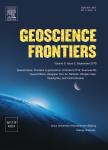The tectonics and mineral systems of Proterozoic Western Australia:Relationships with supercontinents and global secular change
The tectonics and mineral systems of Proterozoic Western Australia:Relationships with supercontinents and global secular change作者机构:Centre for Exploration TargetingThe University of Western AustraliaPerthWestern AustraliaAustralia The Geological Survey of Western AustraliaDepartment of Mines and PetroleumPerthWestern AustraliaAustralia BHP Billiton125 St Georges TerracePerthAustralia ARC Centre of Excellence for Core to Crust Fluid SystemsCentre for Exploration TargetingSchool of Earth SciencesThe University of Western AustraliaAustralia Resource PotentialsPerthAustralia Department of GeologyThe Ministry of Mineral ResourcesGreenland GovernmentGreenland
出 版 物:《Geoscience Frontiers》 (地学前缘(英文版))
年 卷 期:2018年第9卷第2期
页 面:295-316页
核心收录:
学科分类:07[理学] 0708[理学-地球物理学] 0704[理学-天文学]
基 金:supported by the Exploration Incentive Scheme administered by the Geological Survey of Western Australia as part of the Royalties for Regions programme of the Western Australian state government
主 题:Mineral systems Tectonics Australia
摘 要:The cratonisation of Western Australia during the Proterozoic overlapped with several key events in the evolution of Earth. These include global oxidation events and glaciations, as well as the assembly,accretionary growth, and breakup of the supercontinents Columbia and Rodinia, culminating in the assembly of Gondwana. Globally, Proterozoic mineral systems evolved in response to the coupled evolution of the atmosphere, hydrosphere, biosphere and lithosphere. Consequently, mineral deposits form preferentially in certain times, but they also require a favourable tectonic setting. For Western Australia a distinct plate-margin mineralisation trend is associated with Columbia, whereas an intraplate mineralisation trend is associated with Rodinia and Gondwana, each with associated deposit types. We compare the current Proterozoic record of ore deposits in Western Australia to the estimated likelihood of oredeposit formation. Overall likelihood is estimated with a simple matrix-based approach that considers two components: The global secular likelihood and the tectonic setting likelihood. This comparative study shows that at least for the studied ore-deposit types, deposits within Western Australia developed at times, and in tectonic settings compatible with global databases. Nevertheless, several deposit types are either absent or poorly-represented relative to the overall likelihood models. Insufficient exploration may partly explain this, but a genuine lack of deposits is also suggested for some deposit types. This may relate either to systemic inadequacies that inhibited ore-deposit formation, or to poor preservation. The systematic understanding on the record of Western Australia helps to understand mineralisation processes within Western Australia and its past connections in Columbia, Rodinia and Gondwana and aids to identify regions of high exploration potential.



